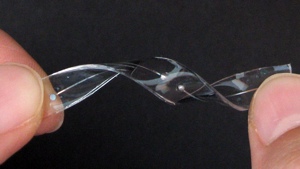Liquid Metal Self-Healing Antenna

As engineers attempt to integrate electronics into things like clothing and medical devices, they’re increasingly running up against the material properties of the substances we use to make the hardware. A lot of the materials that go into a typical electronic device are brittle, inflexible, and prone to damage, and materials scientists are looking at a variety of options for replacing them. A recent paper in Advanced Functional Materials describes a technique for forming an antenna from liquid metal. The resulting (not-so-) hardware is flexible, self-healing, and can change the frequency that it’s sensitive to based on the stress it’s subjected to.
Source: Flexible, self-healing antennae made from liquid metal
The idea behind the new work is pretty simple, as liquid metal is obviously going to be pretty flexible. It’s just as obvious, however, that containing it is also going to be challenging. There are also a limited number of choices when it comes to metals that are liquid anywhere near room temperatures, and not all of those are viable options—nobody’s going to be enthused about bringing anything containing substantial amounts of liquid mercury to the market these days, for example.
The authors focused on an alloy of gallium (which is a liquid at room temperature) and indium, mixed in proportions that minimize the melting temperature. The alloy has a very useful property that came into play during some of the tests performed by the authors: when exposed to the air, it forms a thin oxidized coat that helps keep it from flowing freely.
That oxidized coat isn’t very mechanically robust, so the research team started with a common, flexible polymer called polydimethylsiloxane (PDMS), which is used in a lot of materials science work. For most experiments, the PDMS was molded with an internal channel that was then filled with the gallium-indium mixture and then sealed.
The resulting device was pretty much as flexible as the starting material. It could be flexed, twisted, folded in half, and stretched an additional 40 percent beyond its normal length. When the stress was released, the PDMS snapped back into place; the antenna formed by the liquid metal within remained functional throughout.
The authors could even cut through the antenna with a razor blade and, in many cases, the two ends would spontaneously re-form a single, conducting wire once the blade was removed. In the other cases, the authors simply had to press the severed ends together to get it to re-establish a connection. That’s where the thin oxide layer was critical, as it helped contain the liquid metal within the PDMS when it was cut, but wasn’t robust enough to keep the ends from rejoining.
One of the interesting side-effects of this flexibility is that the physical configuration of the antenna can be changed simply by stretching it, and this will alter the frequencies that it’s sensitive to. Simply by stretching the device 8mm, the peak response could be shifted by over 200MHz.
Obviously, a gallium-indium alloy is going to be a bit more expensive than many of the metals that are currently used in antennae. But the fact that the device is resistant to strain and can self-heal to a degree may make it substantially more durable, which can pay off in the long run. It can also eliminate the need for soldering, as simply jabbing a wire into the liquid should be enough to establish an electrical contact. The authors also suggest that the stress-induced changes in its properties could be put to good use for things like enabling remote monitoring of the integrity of machinery and structures like bridges.
If these things ever make the market, there’s a good chance flexible LEDs will be ready for them.

Leave a Reply
Want to join the discussion?Feel free to contribute!